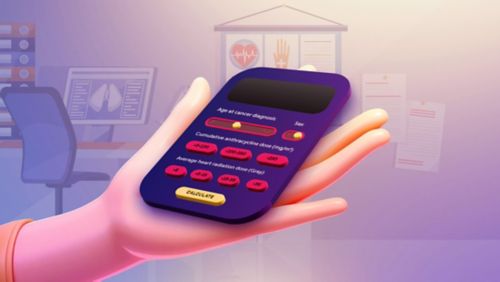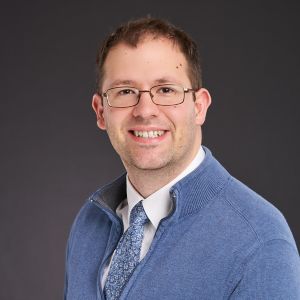St. Jude Family of Websites
Explore our cutting edge research, world-class patient care, career opportunities and more.
St. Jude Children's Research Hospital Home

- Fundraising
St. Jude Family of Websites
Explore our cutting edge research, world-class patient care, career opportunities and more.
St. Jude Children's Research Hospital Home

- Fundraising
St. Jude calculators crunch the numbers to empower survivors of childhood cancer

An artistic rendering of a calculator that helps survivors of childhood cancer determine their risk for later diseases. Graphic by Leena Xaypanya.
When something is high-risk or low-risk, it means that it is more or less likely to expose someone to danger; but how does someone go about calculating risk? Talking about risk can be confusing because sometimes the facts seem counterintuitive, such as how plane travel is much safer than car rides, despite how many people find flying terrifying. Then, there are those risks that happen over the long term, such as risks for significant or later-in-life ailments, including kidney and cardiovascular diseases, the urgency of which can be hard to gauge.
Survivors of childhood cancer experience an increased risk of these diseases, and many more, at a higher rate than their peers, which makes it even more difficult for them to understand their long-term health may look like and make informed decisions. Within the community of survivors, the treatment they received, the type of cancer they had and many other factors influence risk, further complicating the matter. However, understanding risk is important, so St. Jude hosts multiple freely accessible Medical Risk Calculators on the Childhood Cancer Survivor Study (CCSS) and the St. Jude Cloud websites. These tools are made for survivors and their physicians to tailor calculations to their specific details, empowering survivors to find and act on their individual risk for late effects of childhood cancer and its treatment.
“Our population of survivors is distinct,” said Greg Armstrong, MD, MSCE, Department of Epidemiology & Cancer Control chair, who also heads the CCSS. “They’ve received radiation and chemotherapy as children, which changes the game on everything. It changes their risk for heart disease, infertility, second cancers and more. That is why we need survivor-specific health risk calculators.”
Over a decade ago, CCSS put out its first medical risk calculators. These tools used the information that mattered most based on survivorship research, such as cancer treatment exposures and cancer type, to quantify the risk of a survivor experiencing a particular health outcome years later. Yutaka Yasui, PhD, Department of Epidemiology & Cancer Control, helped create this first iteration of risk calculators.
“Long-term risk and screening guidelines existed for survivors, but they were quite broad,” Yasui said. “We already had research data that could make more specific and personalized risk predictions.”
Using the body of research available at the time, Yasui and others built calculators for known late effects of pediatric cancer treatment, such as cardiovascular disease and second cancer. While research existed on many factors that contribute to such late effects, the scientists needed to be selective about what they included.
“We wanted to make more accurate predictions without burdening survivors,” Yasui explained. “Cancer and treatment information is available without an invasive procedure such as a blood draw, so we included predictors that could be easily accessed.”
One intention of the calculators was to decrease survivors’ health care burden, as they should help people avoid unnecessary screenings and focus activities on what matters for their personalized risk. However, those benefits only matter if these calculators are accurate.
Getting to the heart of increasing medical calculators’ accuracy
Though pediatric cancer once had a survival rate of 4%, that number has increased to over 80% in the United States, creating a large group of survivors. Those treated at St. Jude can participate in the St. Jude Lifetime Cohort Study (St. Jude LIFE). While the CCSS relies primarily on self-reported data, St. Jude LIFE measures objective clinical data from survivors over time. Yadav Sapkota, PhD, Department of Epidemiology & Cancer Control, combines data from both cohorts to create more accurate predictions of survivors’ risk for cardiac disease, which he published earlier this year in the Annals of Oncology.
“Those earlier calculations relied solely on self-reports from CCSS, but were only about 74% accurate,” Sapkota said. “We took the data from St. Jude LIFE and created prediction models that were up to 86% accurate in estimating the 10-year risk of cardiomyopathy in survivors.”
Most of the increase in accuracy resulted from using the St. Jude LIFE data as the base for these models, which included clinically assessed health outcomes instead of surveys. Clinical assessment tends to be more accurate and precise than self-reported surveys, though much more difficult to collect, which provided better numbers with which to build the models. Sapkota also incorporated additional significant risk factors affecting the aging survivors, including age itself. He then made several different prediction models based on what data survivors are likely to have available.
The simplest model, which only requires readily accessible data, such as treatment and cancer type, still showed a significant increase in accuracy compared to the previous versions. On the other end of the spectrum, the most complicated model incorporated complex genetic risk information, which showed an even more notable improvement.
“We took genetic variants that are well established in the general population into account,” Sapkota said. “These are variants known to be associated with cardiac diseases and related outcomes. When we incorporated them, we obtained the most accurate model to date.”
After establishing these improved predictive models in the St. Jude LIFE cohort, Sapkota then validated them with the CCSS data. With that confirmation, the St. Jude scientists updated the medical calculator for cardiomyopathy risk, including all five models, so survivors can use whichever one they have enough information for.
Calculators get the most current survivorship research into patients’ hands
Survivorship researchers across St. Jude are continuing to update and improve resources, including these calculators to ensure survivors and their physicians are working with the most accurate information possible when making medical decisions.
“When we get new information, such as data sets or variable types we previously didn’t have, we analyze and add them to these calculators if they improve our predictions,” Yasui explained. “Our goal is to predict long-term risks with sufficient accuracy for clinical application, so each survivor can know their risks and find what action is most optimal for their prevention of late effects.”
While in some scientific disciplines, it can take years to decades to create meaningful information for clinical use, survivorship is different. For example, Sapkota released the improved cardiomyopathy calculators the day his study was published. St. Jude researchers are dedicated ensuring their findings have a meaningful impact on survivors’ lives as soon as possible.
“We’re constantly generating all this scientific knowledge about survivorship care,” Armstrong said. “These calculators are one way, among many, that we are putting that knowledge directly into the hands of survivors and their physicians, empowering them to make informed choices, confident that these resources always represent the most current survivorship research.






